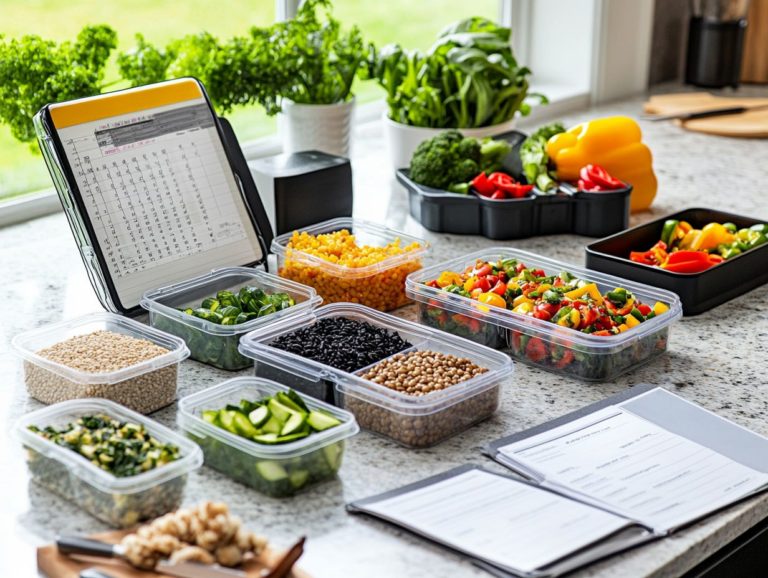How to Meal Plan for a Family of Four
Meal planning can truly be a game changer for you and your family. It offers a range of benefits that extend far beyond mere time and money savings.
Whether you’re navigating the whims of picky eaters or addressing specific dietary restrictions, a well-structured meal plan can streamline your week while ensuring everyone remains satisfied.
Get ready to dive into a step-by-step guide that will empower you to craft an effective meal plan! We will start with an examination of dietary preferences and culminate in efficient grocery shopping and meal prep.
You ll also discover tips for involving your kids in the process and adapting your plans when unexpected challenges arise. Don t wait! Transform mealtime into a stress-free experience for your family starting today!
Contents
- Key Takeaways:
- Benefits of Meal Planning for Families
- Factors to Consider Before Meal Planning
- Creating a Meal Plan
- Shopping for Ingredients
- Meal Prep and Storage
- Involving the Whole Family
- Troubleshooting and Adjusting Meal Plans
- Frequently Asked Questions
- What are the benefits of meal planning for a family of four?
- How do I start meal planning for a family of four?
- How often should I meal plan for a family of four?
- How do I involve my family in the meal planning process?
- What are some budget-friendly meal planning tips for a family of four?
- How can I make meal planning for a family of four more efficient?
Key Takeaways:

Save time and money by meal planning for your family of four.
Consider dietary restrictions and preferences before creating a meal plan.
Follow a step-by-step guide to create a meal plan and efficiently shop for ingredients.
Maximize efficiency and minimize waste with meal prep and storage.
Involve the whole family in meal planning, including kids, to get them excited and invested.
Be prepared to troubleshoot and adjust meal plans for unexpected changes and challenges.
Benefits of Meal Planning for Families
Meal planning offers a wealth of benefits for families. It transforms the cooking experience into something streamlined and enjoyable.
It also promotes healthier eating habits and reduces food waste. By setting aside time to craft a comprehensive meal plan, you ensure that your family enjoys a diverse array of nutritious meals.
All while saving money on groceries and alleviating the stress that comes with last-minute cooking decisions.
Involving your kids in the process fosters healthier food preferences and gives the power to every family member to contribute to a balanced diet.
With thoughtfully designed meal plans featuring wholesome breakfasts, effortless lunches, and satisfying dinners, you can take control of your week’s meals and fully embrace a healthier lifestyle.
Saving Time and Money
One of the most significant benefits of meal planning is your ability to save both time and money. This makes it an essential practice for busy individuals and families alike.
By thoughtfully organizing your meals for the week, you can craft a detailed grocery list that minimizes impulse purchases and reduces wasted ingredients.
This structured approach enables you to buy in bulk, significantly lowering your per-serving costs. It also allows you to prepare budget-friendly meals that don t skimp on quality.
Incorporating techniques like batch cooking (preparing large quantities of food at once) or using one-pot recipes (meals made in a single pot) can enhance your cooking efficiency.
This transforms mealtime into a stress-free experience that preserves both your wallet and your schedule.
Factors to Consider Before Meal Planning
Before you embark on your meal planning journey, it’s crucial to take into account several factors that can shape your family’s diet, including the best practices for weekly meal planning.
Consider dietary restrictions and personal food preferences to craft a healthy meal plan that caters to everyone’s needs. This thoughtful approach ensures that each member of your family feels valued and satisfied at the dining table.
Dietary Restrictions and Preferences
Understanding dietary restrictions and food preferences is essential for crafting a meal plan that accommodates everyone. This allows all family members to relish healthy and delicious meals together.
When planning family dinners, it s important to keep common dietary restrictions in mind. For example, if someone in the family is vegetarian, consider enriching meals with plant-based proteins like lentils or chickpeas.
If gluten intolerance is a concern, you can easily swap traditional pasta for gluten-free alternatives. This enables those affected to enjoy hearty dishes without discomfort.
Managing allergies, such as nut or dairy intolerance, requires a bit of creativity. Think coconut milk or almond flour as safe yet flavorful substitutes.
By thoughtfully incorporating these adjustments, you can create nutritious meal plans that are inclusive and cater to a variety of dietary needs, ensuring that everyone at the table feels satisfied and cared for.
Creating a Meal Plan

Crafting an effective meal plan requires a thoughtful approach. Start by identifying your family’s food preferences, which will help you plan meals for a busy week and set the foundation for your planning.
Next, establish a budget that aligns with your goals. Choose a variety of recipes that encompass various meal categories breakfasts, lunches, dinners, and snacks ensuring there’s something for every palate.
Step-by-Step Guide
A step-by-step guide to meal planning can elevate your cooking experience. It allows you to prepare meals efficiently while enjoying a range of nutritious options throughout the week.
Start by brainstorming meal ideas, considering your dietary preferences and seasonal ingredients. This planning can be fun and helps you eat more sustainably.
Next, select recipes that cater to your tastes and incorporate various cooking techniques from roasting to saut ing promising a delightful week ahead.
Once you’ve chosen your ideal meals, create a shopping list organized into categories for effortless navigation in the store. By determining portion sizes based on your needs, you can minimize waste and optimize nutrition.
Shopping for Ingredients
Effective shopping for ingredients is essential for meal planning. It enables you to stick to your budget while ensuring you have all necessary items to craft delicious and nutritious meals.
Tips for Efficient Grocery Shopping
To enhance your grocery shopping experience, embrace strategic methods that help you stick to your budget while minimizing food waste.
Begin by crafting a grocery list before setting foot in the store. This simple act organizes your shopping trip and ensures you don t overlook essential items, reducing impulse buys.
Consider incorporating meal planning for the week into your routine; this gives you the power to know precisely what you need, allowing for targeted purchases that limit leftovers.
Using store apps or digital coupons can enhance your savings and help maintain control over your spending. Selecting seasonal produce is budget-friendly and reduces waste, as these items are typically fresher and have a longer shelf life.
Meal Prep and Storage
Meal prep and storage are vital elements of a successful meal planning system. Prioritizing these practices enhances your cooking efficiency and enables your family to enjoy nutritious meals throughout the week.
Maximizing Efficiency and Minimizing Waste

Maximizing efficiency during meal prep requires strategic planning and execution. This enables you to minimize food waste while savoring a diverse array of meals.
By organizing your ingredients in advance and crafting a detailed shopping list, you can streamline your grocery trips and avoid pesky impulse buys.
Employing batch cooking techniques allows you to prepare multiple meals simultaneously, saving you both time and energy throughout the week.
Don t shy away from experimenting with creative strategies to repurpose leftovers; yesterday s dinner can easily transform into a brand-new dish. Think of turning roasted vegetables into a hearty soup or a vibrant grain bowl.
Embracing these methods enhances the overall meal prep experience and makes it efficient and enjoyable.
Involving the Whole Family
Getting the whole family involved in meal planning makes cooking fun. It encourages healthy eating habits and teaches kids responsibility.
Getting Kids Involved and Excited About Meal Planning
Involving kids in meal planning can ignite their excitement for cooking and healthy eating. This fosters a more open-minded approach to trying new foods and recipes.
When children have a say in what lands on their plates, their natural curiosity transforms into genuine enthusiasm for the cooking process. Allowing them to select from a range of nutritious recipes makes them more invested in meal preparation.
Turn grocery shopping into an engaging adventure. Letting kids pick out fresh fruits and vegetables not only educates them about healthy choices but also encourages them to taste what they ve selected.
Introduce fun and simple cooking tasks, like assembling healthy snacks. This sparks their creativity and helps them develop foundational kitchen skills that will serve them well for years to come.
Troubleshooting and Adjusting Meal Plans
Unexpected changes can arise even with carefully planned meals. Families need a flexible meal planning system to adapt easily when challenges occur.
This approach gives them the power to make adjustments effortlessly when the need arises.
Dealing with Unexpected Changes and Challenges
Dealing with unexpected changes in schedules or shifting food preferences is common in meal planning. However, with a few versatile tips, you can adapt seamlessly without compromising on nutrition or flavor.
Incorporate quick dinner options that require minimal cooking time to pivot effortlessly when plans change at the last minute.
Utilize leftovers creatively. Transform yesterday s roasted vegetables into a vibrant stir-fry or blend them into a hearty soup.
Keeping a well-stocked pantry with staple ingredients that cater to various dietary preferences provides the flexibility you need for meal preparation.
This way, whether you crave comfort food or a refreshing salad, you can quickly prepare delicious, healthy meals that everyone will love!
Frequently Asked Questions

What are the benefits of meal planning for a family of four?
Meal planning can save you time, money, and reduce food waste. It also allows you to have healthier and more balanced meals for your family.
How do I start meal planning for a family of four?
First, determine your family’s food preferences and dietary restrictions. Then, make a meal planning schedule and refer to meal planning tips for busy families to create a list of recipes and ingredients needed for the week.
How often should I meal plan for a family of four?
It is recommended to plan meals for at least a week at a time. This gives you enough time to shop for ingredients and prepare meals in advance.
How do I involve my family in the meal planning process?
Encourage your family to share their favorite recipes and ask for their input when creating the meal plan. Involve them in grocery shopping and meal prep, making it a fun and collaborative activity.
What are some budget-friendly meal planning tips for a family of four?
Plan meals based on ingredients that are on sale or in season. Buy in bulk when possible and use leftovers for future meals. Incorporate more plant-based meals, as they tend to be more affordable.
How can I make meal planning for a family of four more efficient?
Invest in quality food storage containers and label them with the date and contents to easily keep track of leftovers. Prep ingredients in advance, such as chopping vegetables or marinating meats, to save time during busy weekdays.
Ready to start meal planning? Gather your family and make it a fun activity today!




